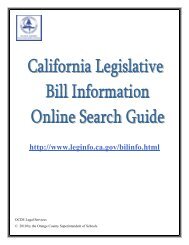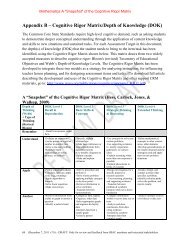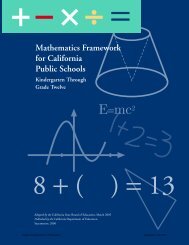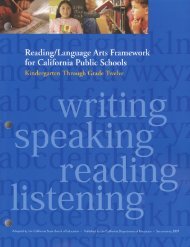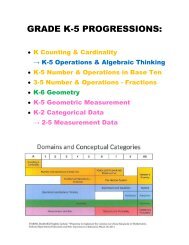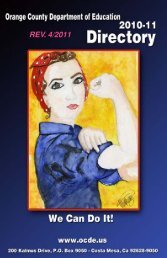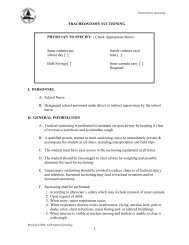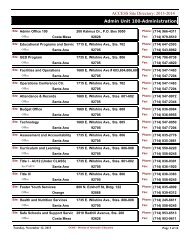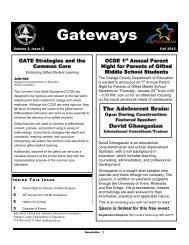The Promise and the Peril for Students with Disabilities - CalSTAT
The Promise and the Peril for Students with Disabilities - CalSTAT
The Promise and the Peril for Students with Disabilities - CalSTAT
You also want an ePaper? Increase the reach of your titles
YUMPU automatically turns print PDFs into web optimized ePapers that Google loves.
Special<br />
<strong>The</strong><br />
EDge<br />
Director, Special<br />
Education Division,<br />
Cali<strong>for</strong>nia Department<br />
of Education<br />
Contract Monitor<br />
<strong>and</strong> Project Liaison<br />
CDE Editorial Consultant<br />
Project Manager<br />
Editor<br />
Editorial Assistant<br />
Content Consultant<br />
Special Contributors<br />
Fred Balcom<br />
Janet Digmon<br />
Erika Hughes<br />
Anne Davin<br />
Mary Cichy Grady<br />
Giselle Blong<br />
Geri West<br />
Linda Brault<br />
Frank Donavan<br />
Laura Fish<br />
Janet M<strong>and</strong>elstam<br />
Martha Thurlow<br />
<strong>The</strong> Special EDge is published three times each<br />
year by <strong>the</strong> Napa County Office of Education’s<br />
<strong>CalSTAT</strong> Project (Cali<strong>for</strong>nia Services <strong>for</strong> Technical<br />
Assistance <strong>and</strong> Training). Funding is provided<br />
by <strong>the</strong> Cali<strong>for</strong>nia Department of Education,<br />
Special Education Division, through contract<br />
number CN100006 <strong>with</strong> Napa County Office<br />
of Education (NCOE), <strong>and</strong> from federal funds,<br />
State Grants #H027A080116A. Opinions<br />
expressed herein are those of <strong>the</strong> authors <strong>and</strong><br />
do not necessarily represent <strong>the</strong> position of <strong>the</strong><br />
U.S. Department of Education, <strong>the</strong> Cali<strong>for</strong>nia<br />
Department of Education, or Napa County<br />
Office of Education; nor does mention of trade<br />
names, commercial products, or organizations<br />
imply endorsement.<br />
Circulation: 51,000<br />
<strong>The</strong> in<strong>for</strong>mation in this issue is in <strong>the</strong> public<br />
domain unless o<strong>the</strong>rwise indicated. Readers are<br />
encouraged to copy <strong>and</strong> share but to credit Cal-<br />
STAT. This issue is available on disk, audiotape,<br />
<strong>and</strong> in large type upon request. By going to<br />
<strong>CalSTAT</strong>’s Web site — www.calstat.org/info<br />
Publications.html — you can download PDF<br />
<strong>and</strong> text versions of this <strong>and</strong> previous newsletters.<br />
Contact <strong>The</strong> Special EDge by phone at 707-<br />
849-2275; e-mail at giselle.blong@calstat.org;<br />
or mail:<br />
<strong>The</strong> Special EDge, c/o NCOE/<strong>CalSTAT</strong>,<br />
5789 State Farm Drive, Suite 230,<br />
Rohnert Park, Cali<strong>for</strong>nia 94928<br />
In<strong>for</strong>ming <strong>and</strong> supporting<br />
parents, educators, <strong>and</strong> o<strong>the</strong>r<br />
service providers on special<br />
education topics, focusing<br />
on research-based practices,<br />
legislation, technical support,<br />
<strong>and</strong> current resources<br />
Letter<br />
Fred Balcom<br />
CA Dept. of Education<br />
Special Education Division<br />
from <strong>the</strong> State Director<br />
Summer offers a great opportunity to reflect on what<br />
we’ve accomplished <strong>and</strong> what we face. One recent decision<br />
that carries enormous significance <strong>for</strong> <strong>the</strong> future of education<br />
is <strong>the</strong> adoption of <strong>the</strong> Common Core State St<strong>and</strong>ards (CCSS).<br />
Cali<strong>for</strong>nia joined that initiative because of its promise to be<br />
a unified, national ef<strong>for</strong>t to secure consistent academic rigor<br />
<strong>for</strong> our K–12 school system. <strong>The</strong> importance of a strong<br />
system of academics that gives all students <strong>the</strong> opportunity<br />
to realize <strong>the</strong>ir full potential has always been part of both<br />
state <strong>and</strong> national agendas. <strong>The</strong> idea of national educational<br />
consistency is relatively new. However, <strong>with</strong>in just <strong>the</strong> past<br />
two decades our world has seen accelerated technological<br />
innovations <strong>and</strong> global interdependencies that require us<br />
as a nation to embrace rigorous st<strong>and</strong>ards that, to ensure optimal benefit <strong>for</strong> every<br />
student, are <strong>the</strong> same across all 50 states. If our country is to remain competitive <strong>and</strong><br />
if our children are to realize promising futures, we must be certain that our schools<br />
prepare all students <strong>for</strong> postsecondary education <strong>and</strong> employment. This is <strong>the</strong> idea of<br />
<strong>the</strong> CCSS. It is not just a good idea; it is a necessary one.<br />
Our hope all along has been that, when we implement <strong>the</strong> CCSS, students <strong>with</strong><br />
disabilities will have <strong>the</strong> supports, services, accommodations, <strong>and</strong> modifications <strong>the</strong>y<br />
need to realize <strong>the</strong> same educational benefit that all o<strong>the</strong>r students receive. What<br />
makes <strong>the</strong> CCSS potentially unique is <strong>the</strong> chance it presents to build each of <strong>the</strong>se<br />
components into <strong>the</strong> st<strong>and</strong>ards <strong>and</strong> accompanying curriculum <strong>and</strong> assessments from<br />
<strong>the</strong> very beginning, as was <strong>the</strong> promise—<strong>and</strong> not added as an afterthought. (Thurlow<br />
page 1.)<br />
Some educators of good will have argued <strong>for</strong> field-testing <strong>the</strong> CCSS be<strong>for</strong>e <strong>the</strong>ir<br />
wholesale launch. I suggest, however, that we know what to teach, <strong>and</strong> we know how<br />
to help students learn. <strong>The</strong> real challenge is lodged in those detailed cracks that only<br />
appear during <strong>the</strong> actual, large-scale movement <strong>for</strong>ward. No preliminary “testing <strong>the</strong><br />
waters” can prepare us <strong>for</strong> <strong>the</strong> task of actually implementing <strong>the</strong> st<strong>and</strong>ards. And we<br />
are preparing. We know that districts are quickly ramping up supplemental materials<br />
<strong>and</strong> curriculum to address <strong>the</strong> CCSS in <strong>the</strong> classroom prior to <strong>the</strong> first year of <strong>the</strong><br />
new assessment system (2014–2015). Many of <strong>the</strong>se districts (page 16) are showing<br />
commitment, energy, <strong>and</strong> careful thought in how <strong>the</strong>y’re preparing <strong>the</strong>ir teachers<br />
<strong>and</strong> programs to embrace <strong>and</strong> benefit from <strong>the</strong> new st<strong>and</strong>ards. Since assessment is a<br />
central part of this new initiative, key Cali<strong>for</strong>nia stakeholders have asked to join <strong>the</strong><br />
National Collaborative <strong>and</strong> State Consortium to assist <strong>and</strong> advise in <strong>the</strong> development<br />
of a CCSS assessment <strong>for</strong> students <strong>with</strong> severe cognitive disabilities <strong>and</strong> to work in<br />
concert <strong>with</strong> <strong>the</strong> Smarter Balanced Assessment Consortia assessment that is being<br />
designed <strong>for</strong> all o<strong>the</strong>r students. <strong>The</strong> assessment system that Cali<strong>for</strong>nia will ultimately<br />
use <strong>for</strong> this group of students is uncertain; it is one of <strong>the</strong> important decisions that<br />
still needs to be made (Donavan, page 5).<br />
We have much cause <strong>for</strong> optimism as we move <strong>for</strong>ward. Our schools have come a<br />
long way in realizing true educational benefit <strong>for</strong> students <strong>with</strong> disabilities (Donavan,<br />
page 3). Research continues to reveal what is required of <strong>and</strong> <strong>for</strong> healthy brain<br />
development so that all children can meet rigorous st<strong>and</strong>ards <strong>and</strong> realize <strong>the</strong>ir full<br />
potential (Fish <strong>and</strong> Brault, page 9). Meanwhile, <strong>the</strong> Cali<strong>for</strong>nia Advisory Commission<br />
on Special Education (see insert) continues to be diligent in championing legislation<br />
<strong>and</strong> programs that benefit students. And <strong>the</strong> Special Education Division remains<br />
firmly committed to ensuring that <strong>the</strong> CCSS initiative, along <strong>with</strong> all of its attendant<br />
pieces, is crafted in a way that supports <strong>and</strong> benefits all students <strong>with</strong> disabilities.<br />
2 u <strong>The</strong> Common Core State St<strong>and</strong>ards Summer 2012 u <strong>The</strong> Special EDge





